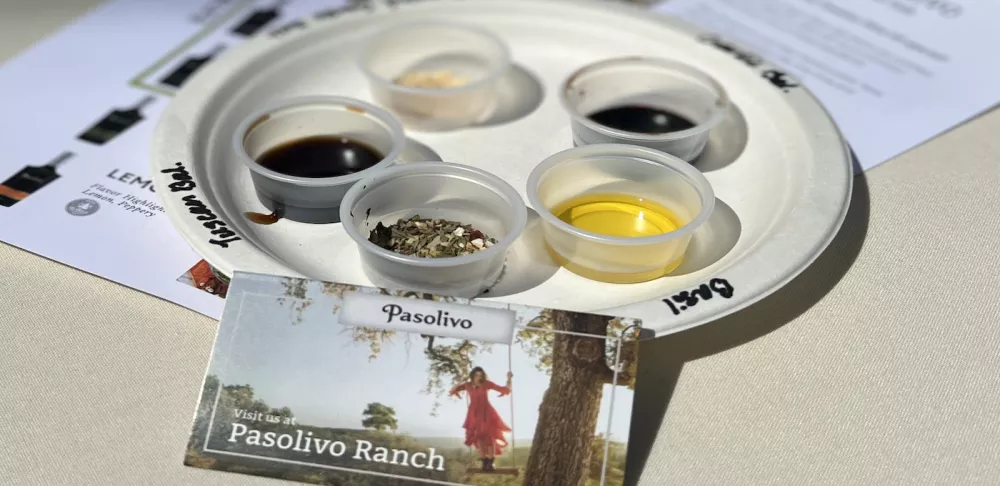Olive oil is a product that chefs use all of the time, but may not know very much about when it comes to the subtle nuances.
Having previously offered a deep dive on our other favorite fat, butter, here we get into the nitty gritty when it comes to one of the most versatile cooking fats: olive oil.
Marisa Bloch, General Manager and Master Blender of California’s Pasolivo Olive Oil is a level two certified olive oil sommelier, a credential that represents a rising trend for food professionals that want the deepest possible understanding of what is arguably one of the culinary realm’s most important staples.
Offered periodically as a week-long seminar by the Olive Oil Times, Marisa says the process for becoming an olive oil sommelier is intense.
“We tasted hundreds of olive oils from all over the world, and learned how to identify the positive attributes of the oils,” she says. “You can identify the different varieties and know where they came from just by tasting.”
Additionally, the seminar focused on tasting unwanted flavors in olive oils, and how to tell if a product had spoiled. “That was not my favorite day,” she says, but adds that tasting those incorrect flavors equips an olive oil sommelier to be able to identify them just by smell in the future.
As a certified olive oil sommelier and professional, Marisa takes us through seven of the key things you should understand about olive oil.
Extra-Virgin Certification
Most people with a culinary focus already understand that the words “extra-virgin” are extremely important when selecting an olive oil, meaning that the oil comes from the first pressing of the olives, but Marisa suggests that you should take it a step further.
“Look for extra-virgin certification,” she says. “There are a lot of bottles that will say extra-virgin olive oil, but not all of them are actually extra-virgin. Certification is key because that means that the oil has gone through all the proper milling practices, all of the lab testing and the blind tasting aspects.”
There are several qualified institutions who do extra-virgin olive oil certification, including the California Olive Oil Council, the International Olive Oil Council and several private organizations both domestically and internationally.
Read More: The Golden State's Liquid Gold >
Know Your Olives
Different varieties of olives have distinct flavors and certain types are better suited for different cooking applications. You don’t need to be an olive oil sommelier to become familiar with a few common varieties and their attributes.
For example, the Arbequina olive, which is grown both in Spain and California, is a mild variety of olive.
“The mild varieties, like Arbequina, are really nice for any type of cooking you want to do, and won’t change the flavor of what you’re cooking,” Marisa says.
If you're cooking more flavorful vegetables, or meat, however, you may want to use an oil with a stronger flavor.
“Tuscan varieties such as Frantoio, Leccino and Pendolino are known for being really full, robust, pungent and peppery,” Marisa says. “Those are really nice to balance out any acidic foods, so they are great on tomatoes, for example, and they also stand up really well to meat. Olive oil is actually a great meat tenderizer.”
And of course, there is the classic earthy olive oil for more gentle cooking applications.
“Then there's also other Spanish olives like Mission and Manzanilla, and the French variety Picholine, that tend to be more on the grassy side, and can sometimes have more bitterness to them,” she says. “Depending on how green they are when the olives are picked, those are really nice on vegetables, lighter seafood and things like that.”
Let There Not Be Light
When it comes to choosing quality olive oil, it isn’t only the text on the bottle that’s key, but the bottle itself.
“Dark packaging is really important,” Marisa says. “We paint our bottles black, some people do white, or even use tins or bags for olive oil, but you want something that's going to completely block out the light. Even the dark green glass does let some light in.”
This is also key when storing your olive oil at home, as it should be kept somewhere that is cool and free from direct light of any kind.
Olive Oil Vintage
Olive oil doesn’t necessarily express vintage variation in the same way that wine does, but you should look for information about when the olives were harvested.
“You also want to look for a harvest date or a best buy date,” Marisa says. “Some oils will just have a bottling date, but that doesn't tell you when the oil is produced. You want to use olive oil within two years of that harvest date to make sure you're receiving not only the best flavor but those optimal health benefits.”
Single Origin Oil
Be wary of blends, Marisa cautions, and instead look for olive oils that express a single origin.
“Sometimes you'll see that the origin of the oil was from Italy, France and Spain, and that sounds really romantic,” Marisa says. “All of these places make really wonderful oil but the reality is that those oils had to travel from each of those locations to get bottled together, which runs the risk of quality. Every time you're moving around that oil, there's definitely a risk.”
When Your Olive Oil is Off
Olive oil isn’t forever, and you should look for signs that your oil has turned. Rancid olive oil won’t hurt you, but there’s no point in using high quality, fresh ingredients if you’re going to cook them in an oil that is past its prime.
According to Marisa, there are both aromas and textures that can indicate that your olive oil has turned.
“You want to get a really strong nose on the olive oil,” she says. “It should smell and taste like olives. You don't want it to smell like nothing or taste really bland. Also it should have nice oil qualities to it but it shouldn't leave an oily residue on your lips or in your mouth at all. If an oil has started to turn rancid, it will leave behind an oily sensation.”
Olive Oil is Versatile
Olive oil is extremely versatile, and can be used for both cooking and baking.
“A big misconception with olive oil is that you can't do high-heat cooking with it,” Marisa says.
However a high quality, extra-virgin olive oil should have a smoke point between 375˚F and 400˚F, making it suitable for most cooking methods. For baking, a mild-flavored olive oil can be substituted for either butter or vegetable oil in most recipes, lending just a hint of a savory edge to your dishes.
More Deep Dives:






